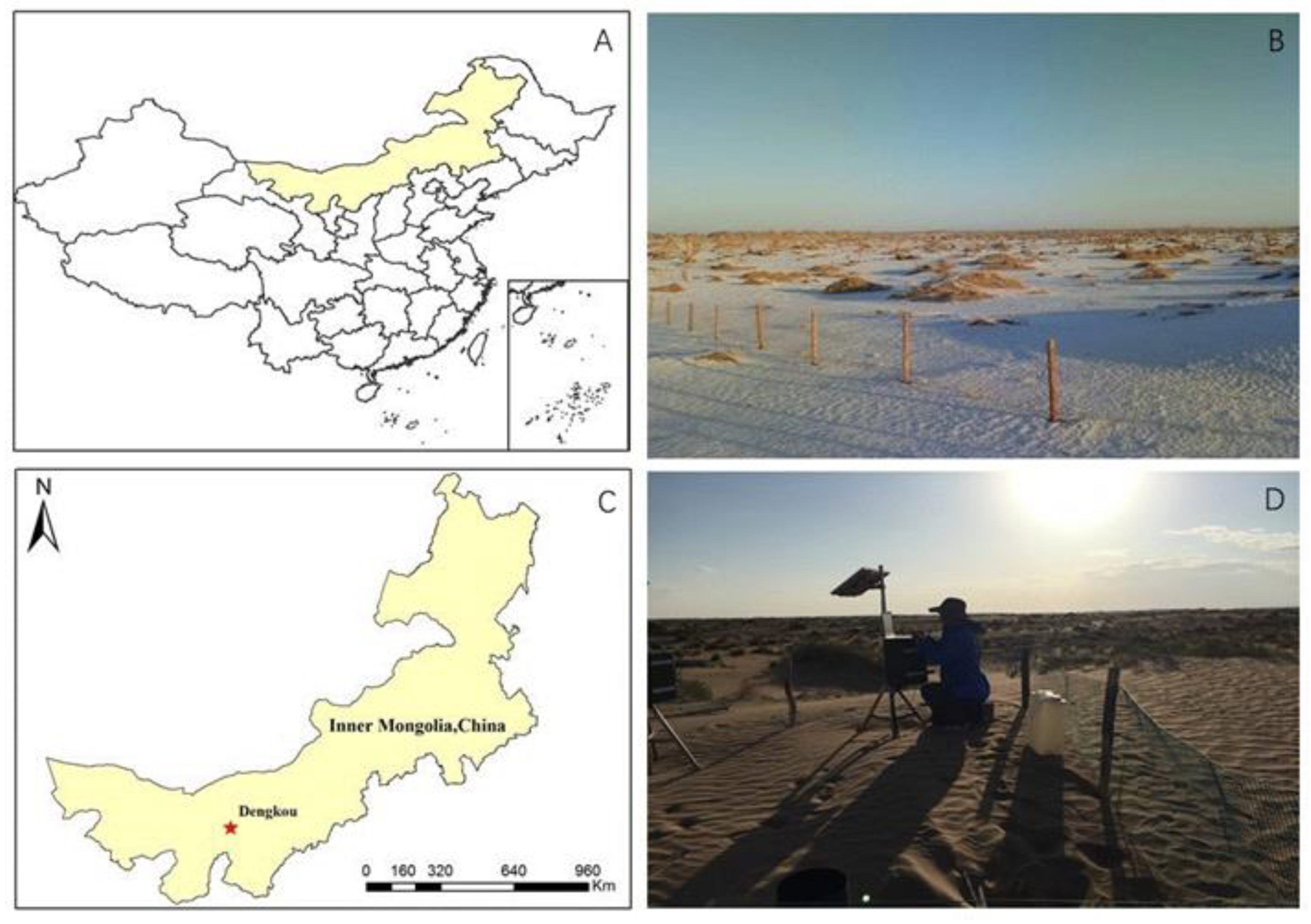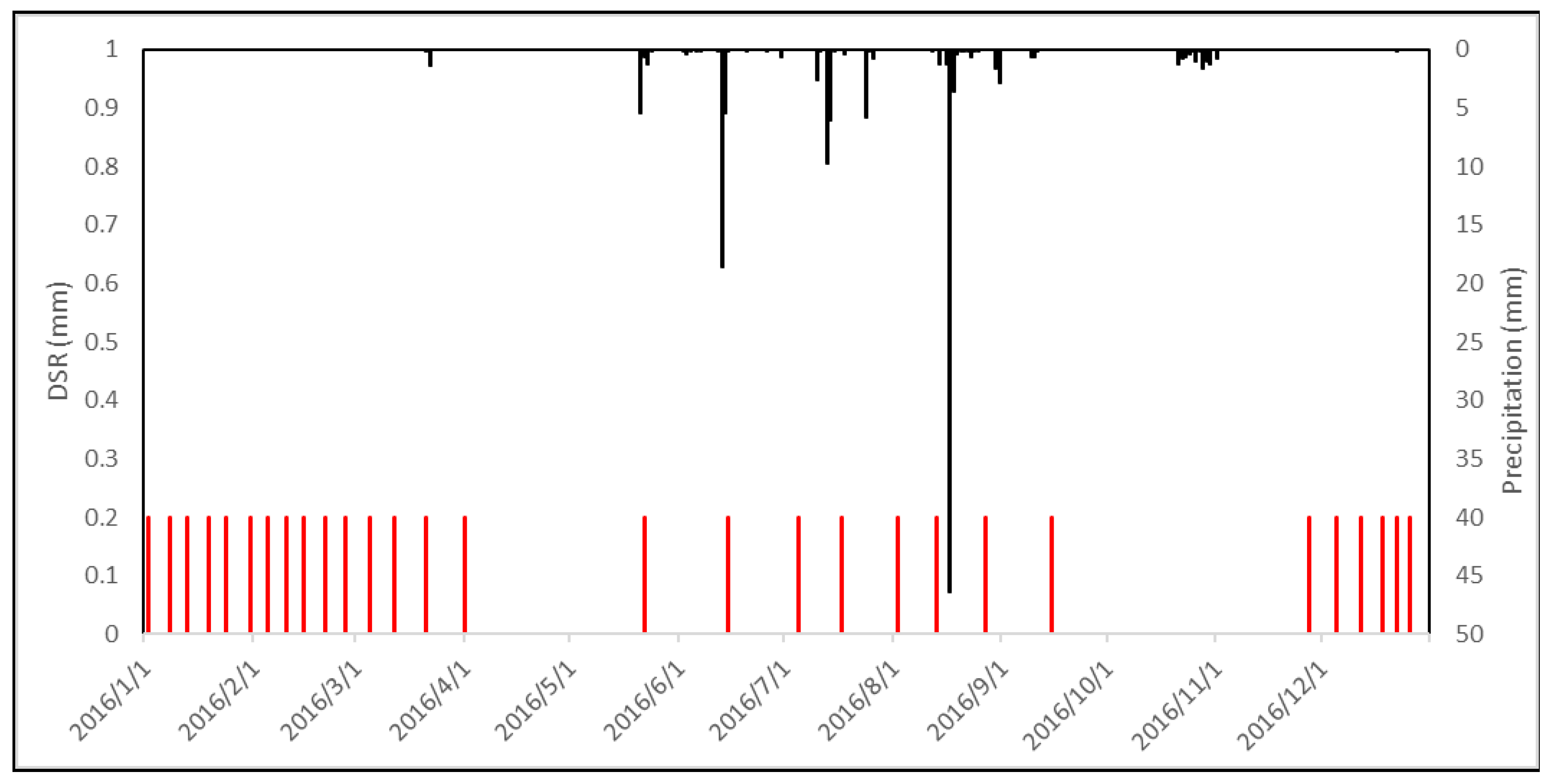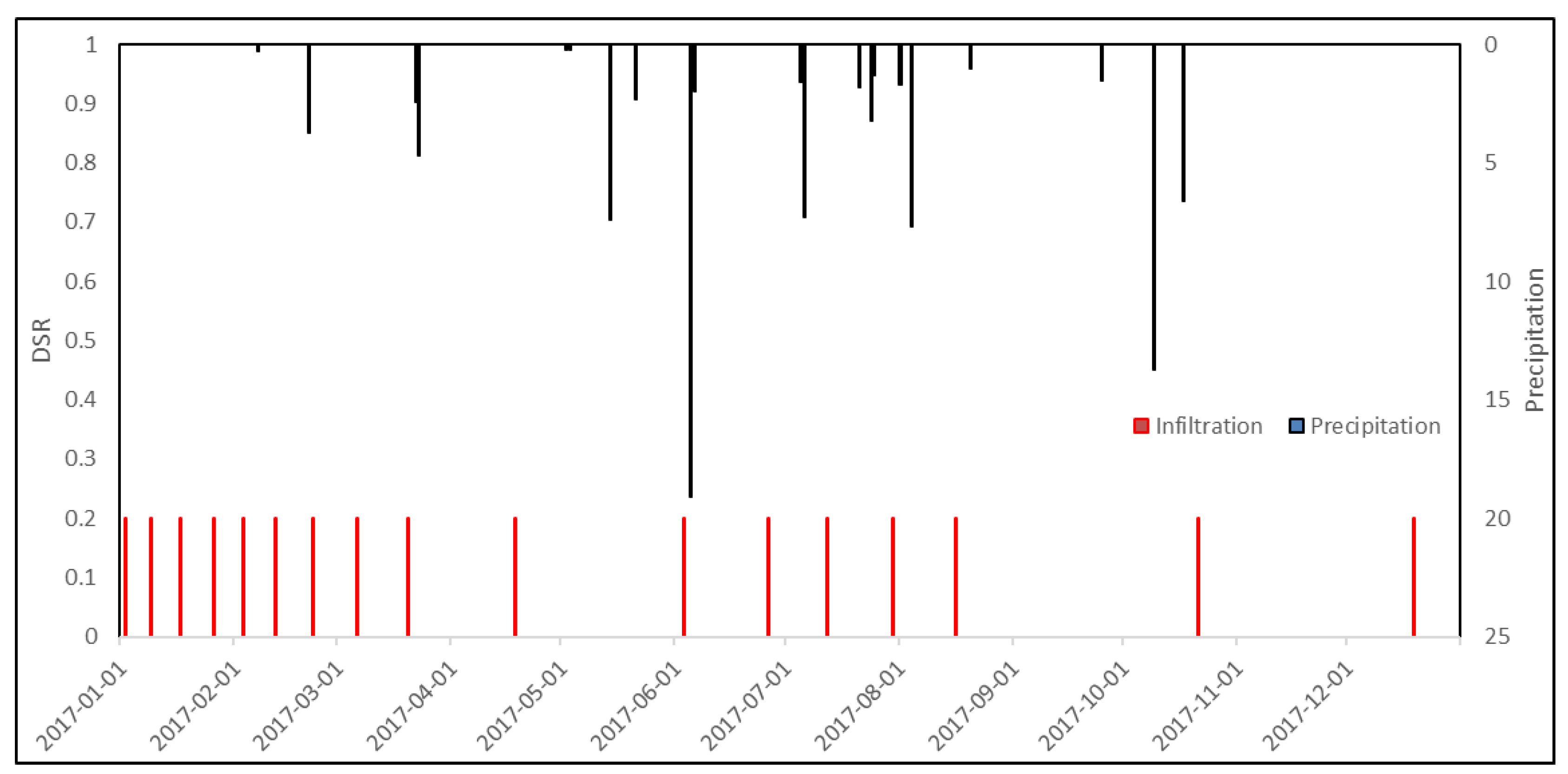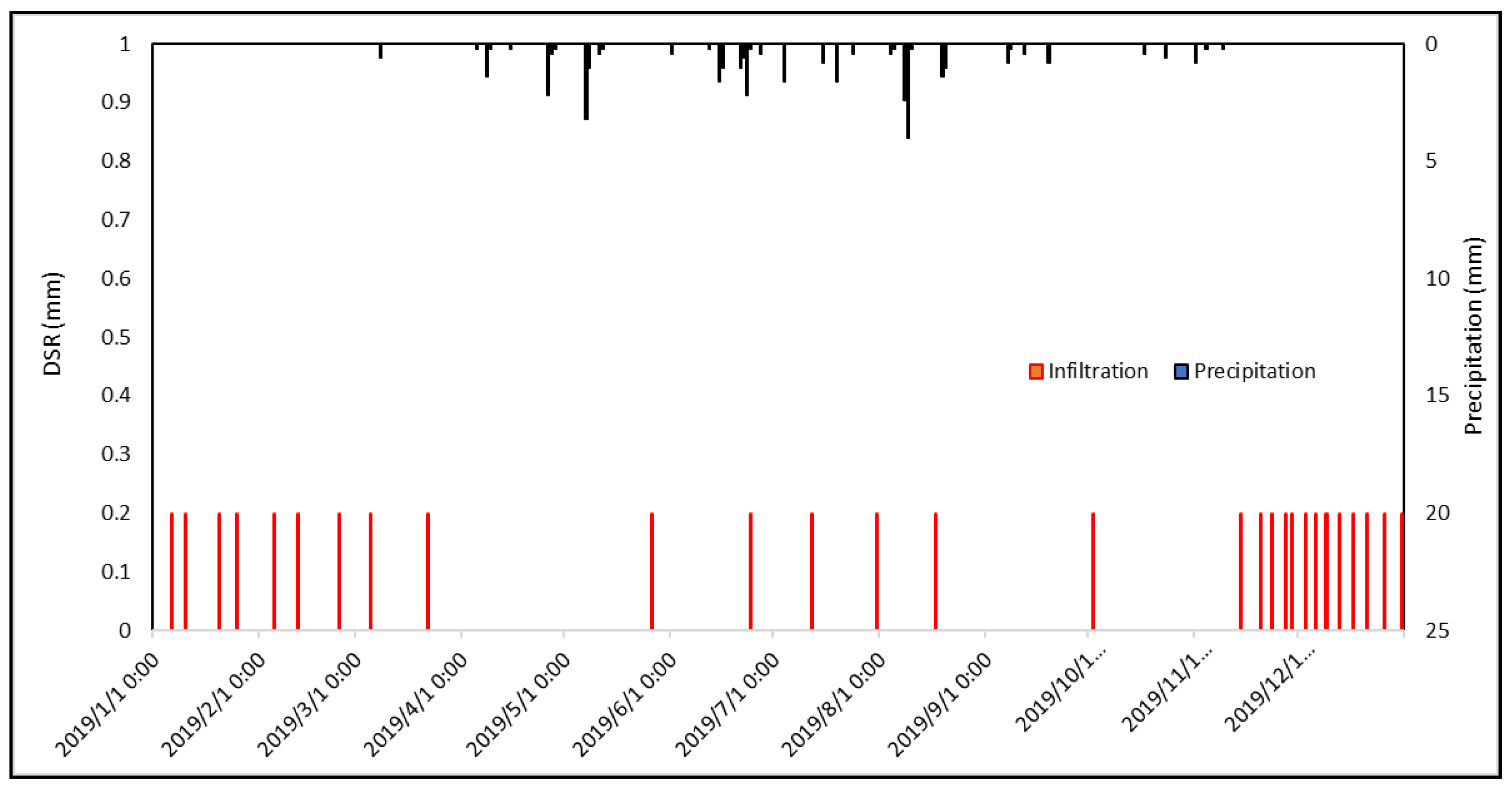On the Origin of Deep Soil Water Infiltration in the Arid Sandy Region of China
Abstract
1. Introduction
2. Seasonal Characteristics of Shallow Soil in an Arid Sandy Region
3. Material and Methods
3.1. Overview of the Experimental Plot
3.2. Experiment Design
3.2.1. Observation of Annual Evapotranspiration
3.2.2. Observation on Annual Precipitation and DSR
3.2.3. Observation on Frozen Soil Thickness Change
4. Results and Analysis
4.1. The Annual Tendency of Change on Evaporation
4.2. The Inter-Annual Trends of Precipitation and DSR
5. Discussion
6. Conclusions
- Even with an annual precipitation of 48.2 mm in a very dry year in the arid sandy region, DSR is still recorded at a depth of 200 cm, signifying that groundwater recharge is possible during such a dry year. The threshold of daily precipitation that can induce DSR is around 4 mm in the arid sandy region, and DSR can be recorded under frozen surface layer conditions in winter and spring seasons.
- There is no direct correlation between the amount of DSR and the annual precipitation in the arid sandy region. Most recorded DSR events are concentrated in the freeze–thaw period in winter and spring seasons. The instantaneous rainstorm in the arid sandy region has no obvious replenishment effect on DSR.
- The ice and snow accumulated in the frozen season in winter and spring will not replenish the deep soil moisture in the freeze–thaw season. Instead, the condensed water in the deep soil is the main source of DSR in the freeze–thaw season. The amount of DSR replenishment during the rainy season in the arid sandy region is less than that during the winter and spring freeze–thaw season.
Author Contributions
Funding
Acknowledgments
Conflicts of Interest
References
- Zarch, M.A.A.; Malekinezhad, H.; Mobin, M.H.; Dastorani, M.T.; Kousari, M.R. Drought monitoring by reconnaissance drought index (RDI) in Iran. Water Res. Manag. 2011, 25, 3485. [Google Scholar] [CrossRef]
- Ren, W.; Tian, H.; Chen, G.; Liu, M.; Zhang, C.; Chappelka, A.H.; Pan, S. Influence of ozone pollution and climate variability on net primary productivity and carbon storage in China’s grassland ecosystems from 1961 to 2000. Environ. Pollut. 2007, 149, 327–335. [Google Scholar] [CrossRef] [PubMed]
- Cramer, W.; Kicklighter, D.W.; Bondeau, A.; Iii, B.M.; Churkina, G.; Nemry, B.; Ruimy, A.; Schloss, A.L. Intercomparison, Comparing global models of terrestrial net primary productivity (NPP): Overview and key results. Glob. Change Biol. 1999, 5 (Suppl. S1), 1–15. [Google Scholar] [CrossRef]
- LeBauer, D.S.; Treseder, K.K. Nitrogen limitation of net primary productivity in terrestrial ecosystems is globally distributed. Ecology 2008, 89, 371–379. [Google Scholar] [CrossRef]
- Haberl, H.; Erb, K.-H.; Krausmann, F. Human appropriation of net primary production: Patterns, trends, and planetary boundaries. Ann. Rev. Environ. Res. 2014, 39, 363–391. [Google Scholar] [CrossRef]
- Seifan, M. Long-term effects of anthropogenic activities on semi-arid sand dunes. J. Arid Environ. 2009, 73, 332–337. [Google Scholar] [CrossRef]
- Ma, Z.; Xie, Y.; Jiao, J.; Wang, X. The construction and application of an Aledo-NDVI based desertification monitoring model. Proc. Environ. Sci. 2011, 10, 2029–2035. [Google Scholar] [CrossRef]
- Modarres, R.V.; da Silva, P.R. Rainfall trends in arid and semi-arid regions of Iran. J. Arid Environ. 2007, 70, 344–355. [Google Scholar] [CrossRef]
- Cao, S.; Chen, L.; Shankman, D.; Wang, C.; Wang, X.; Zhang, H. Excessive reliance on afforestation in China’s arid and semi-arid regions: Lessons in ecological restoration. Earth-Sci. Rev. 2011, 104, 240–245. [Google Scholar] [CrossRef]
- Chen, C.; Park, T.; Wang, X.; Piao, S.; Xu, B.; Chaturvedi, R.K.; Fuchs, R.; Brovkin, V.; Ciais, P.; Fensholt, R. China and India lead in greening of the world through land-use management. Nat. Sustain. 2019, 2, 122–129. [Google Scholar] [CrossRef]
- Cao, S.; Chen, L.; Yu, X. Impact of China’s grain for green project on the landscape of vulnerable arid and semi-arid agricultural regions: A case study in northern Shaanxi Province. J. Appl. Ecol. 2009, 46, 536–543. [Google Scholar] [CrossRef]
- Jiang, Z.; Lian, Y.; Qin, X. Rocky desertification in Southwest China: Impacts, causes, and restoration. Earth-Sci. Rev. 2014, 132, 1–12. [Google Scholar] [CrossRef]
- Wang, Y.; Shao, M.A.; Zhu, Y.; Liu, Z. Impacts of land use and plant characteristics on dried soil layers in different climatic regions on the Loess Plateau of China. Agric. For. Meteorol. 2011, 151, 437–448. [Google Scholar] [CrossRef]
- Kleidon, A.; Fraedrich, K.; Heimann, M. A green planet versus a desert world: Estimating the maximum effect of vegetation on the land surface climate. Clim. Chang. 2000, 44, 471–493. [Google Scholar] [CrossRef]
- Huxman, T.E.; Snyder, K.A.; Tissue, D.; Leffler, A.J.; Ogle, K.; Pockman, W.T.; Sandquist, D.R.; Potts, D.L.; Schwinning, S. Precipitation pulses and carbon fluxes in semiarid and arid ecosystems. Oecologia 2004, 141, 254–268. [Google Scholar] [CrossRef] [PubMed]
- Agam, N.; Berliner, P.R. Dew formation and water vapor adsorption in semi-arid environments—a review. J. Arid Environ. 2006, 65, 572–590. [Google Scholar] [CrossRef]
- Pan, Y.-X.; Wang, X.-P.; Zhang, Y.-F. Dew formation characteristics in a revegetation-stabilized desert ecosystem in Shapotou area, Northern China. J. Hydrol. 2010, 387, 265–272. [Google Scholar] [CrossRef]
- Kidron, G.J. Analysis of dew precipitation in three habitats within a small arid drainage basin, Negev Highlands, Israel. Atmos. Res. 2000, 55, 257–270. [Google Scholar] [CrossRef]
- Tweed, S.; Leblanc, M.; Cartwright, I.; Favreau, G.; Leduc, C. Arid zone groundwater recharge and salinisation processes; an example from the Lake Eyre Basin, Australia. J. Hydrol. 2011, 408, 257–275. [Google Scholar] [CrossRef]
- Gran, M.; Carrera, J.; Massana, J.; Saaltink, M.W.; Olivella, S.; Ayora, C.; Lloret, A. Dynamics of water vapor flux and water separation processes during evaporation from a salty dry soil. J. Hydrol. 2011, 396, 215–220. [Google Scholar] [CrossRef]
- Jolly, I.D.; McEwan, K.L.; Holland, K.L. A review of groundwater–surface water interactions in arid/semi-arid wetlands and the consequences of salinity for wetland ecology. Ecohydrol. Ecosyst. Land Water Process Interact. Ecohydrogeomorphol. 2008, 1, 43–58. [Google Scholar] [CrossRef]
- Wang, G.-X.; Cheng, G.-D. The characteristics of water resources and the changes of the hydrological process and environment in the arid zone of northwest China. Environ. Geol. 2000, 39, 783–790. [Google Scholar] [CrossRef]
- Sternberg, T. Environmental challenges in Mongolia’s dryland pastoral landscape. J. Arid Environ. 2008, 72, 1294–1304. [Google Scholar] [CrossRef]
- Wheater, H. Hydrological Processes, Groundwater Recharge and Surface-Water/Groundwater Interactions in Arid and Semi-Arid Areas. Groundwater Modeling in Arid and Semi-Arid Areas, 1st ed.; Cambridge University Press: Cambridge, UK, 2010; pp. 5–37. [Google Scholar]
- Zhuang, Y.; Zhao, W. Advances in the condensation water of arid regions. Adv. Earth Sci. 2008, 23, 31–38. [Google Scholar]
- Cui, Y.; Shao, J. The role of ground water in arid/semiarid ecosystems, Northwest China. Groundwater 2005, 43, 471–477. [Google Scholar] [CrossRef]
- Brodersen, C.; Pohl, S.; Lindenlaub, M.; Leibundgut, C.; Wilpert, K.V. Influence of vegetation structure on isotope content of throughfall and soil water. Hydrol. Process. 2000, 14, 1439–1448. [Google Scholar] [CrossRef]
- Bostic, E.; White, J. Soil phosphorus and vegetation influence on wetland phosphorus release after simulated drought. Soil Sci. Soc. Am. J. 2007, 71, 238–244. [Google Scholar] [CrossRef]
- Rodriguez-Iturbe, I.; D’odorico, P.; Porporato, A.; Ridolfi, L. On the spatial and temporal links between vegetation, climate, and soil moisture. Water Res. Res. 1999, 35, 3709–3722. [Google Scholar] [CrossRef]
- Gerten, D.; Schaphoff, S.; Haberlandt, U.; Lucht, W.; Sitch, S. Terrestrial vegetation and water balance—hydrological evaluation of a dynamic global vegetation model. J. Hydrol. 2004, 286, 249–270. [Google Scholar] [CrossRef]
- Musa, A.; Ya, L.; Anzhi, W.; Cunyang, N. Characteristics of soil freeze–thaw cycles and their effects on water enrichment in the rhizosphere. Geoderma 2016, 264, 132–139. [Google Scholar] [CrossRef]
- Allington, G.; Valone, T. Reversal of desertification: The role of physical and chemical soil properties. J. Arid Environ. 2010, 74, 973–977. [Google Scholar] [CrossRef]
- Feng, Q.; Cheng, G.; Endo, K. Water content variations and respective ecosystems of sandy land in China. Environ. Geol. 2001, 40, 1075–1083. [Google Scholar]
- Qi, F.; Kunihiko, E.; Guodong, C. Soil water and chemical characteristics of sandy soils and their significance to land reclamation. J. Arid Environ. 2002, 51, 35–54. [Google Scholar] [CrossRef]
- Wang, X.P.; Li, X.R.; Xiao, H.L.; Berndtsson, R.; Pan, Y.X. Effects of surface characteristics on infiltration patterns in an arid shrub desert. Hydrol. Process. Int. J. 2007, 21, 72–79. [Google Scholar] [CrossRef]
- Cheng, Y.; Zhan, H.; Yang, W.; Dang, H.; Li, W. Is annual recharge coefficient a valid concept in arid and semi-arid regions? Hydrol. Earth Syst. Sci. 2017, 21, 5031. [Google Scholar] [CrossRef]
- Cheng, Y.; Li, Y.; Zhan, H.; Liang, H.; Yang, W.; Zhao, Y.; Li, T. New comparative experiments of different soil types for farmland water conservation in arid regions. Water 2018, 10, 298. [Google Scholar] [CrossRef]
- Li, S.; Xiao, H.; Cheng, Y.; Wang, F. Water use measurement by non-irrigated Tamarix ramosissima in arid regions of Northwest China. Sci. Cold Arid Reg. 2015, 7, 146–156. [Google Scholar]
- Zhao, L.; Gray, D. Estimating snowmelt infiltration into frozen soils. Hydrol. Process. 1999, 13, 1827–1842. [Google Scholar] [CrossRef]
- Chun, X.; Chen, F.-H.; Fan, Y.-X.; Xia, D.-S.; Zhao, H. Formation of Ulan Buh Desert and its environmental evolution. J. Desert Res. 2007, 6, 193–199. [Google Scholar]
- Tian, Y.; He, Y.; Guo, L. Soil water carrying capacity of vegetation in the northeast of Ulan Buh Desert, China. Front. For. China 2009, 4, 309–316. [Google Scholar] [CrossRef]
- McMahon, T.; Peel, M.; Lowe, L.; Srikanthan, R.; McVicar, T. Estimating actual, potential, reference crop and pan evaporation using standard meteorological data: A pragmatic synthesis. Hydrol. Earth Syst. Sci. 2013, 17, 1331–1363. [Google Scholar] [CrossRef]
- Zuo, X.; Zhao, X.; Zhao, H.; Zhang, T.; Guo, Y.; Li, Y.; Huang, Y. Spatial heterogeneity of soil properties and vegetation–soil relationships following vegetation restoration of mobile dunes in Horqin Sandy Land, Northern China. Plant Soil 2009, 318, 153–167. [Google Scholar] [CrossRef]
- Zhang, J.; Zhao, H.; Zhang, T.; Zhao, X.; Drake, S. Community succession along a chronosequence of vegetation restoration on sand dunes in Horqin Sandy Land. J. Arid Environ. 2005, 62, 555–566. [Google Scholar] [CrossRef]
- Liu, Q.; Yasufuku, N.; Miao, J.; Ren, J. An approach for quick estimation of maximum height of capillary rise. Soils Found. 2014, 54, 1241–1245. [Google Scholar] [CrossRef]
- Puigdefábregas, J.; Sole, A.; Gutierrez, L.; del Barrio, G.; Boer, M.J.E.-S.R. Scales and processes of water and sediment redistribution in drylands: Results from the Rambla Honda field site in Southeast Spain. Earth Sci. Rev. 1999, 48, 39–70. [Google Scholar] [CrossRef]
- Massmann, G.; Sültenfuß, J. Identification of processes affecting excess air formation during natural bank filtration and managed aquifer recharge. J. Hidrol. 2008, 359, 235–246. [Google Scholar] [CrossRef]
- Ferguson, B.K. Stormwater Infiltration; CRC Press: Boca Raton, FL, USA, 1994. [Google Scholar]
- Chen, X.; Hu, Q.J.J. Groundwater influences on soil moisture and surface evaporation. J. Hidrol. 2004, 297, 285–300. [Google Scholar] [CrossRef]
- Cerdà, A. Seasonal variability of infiltration rates under contrasting slope conditions in southeast Spain. Geoderma 1996, 69, 217–232. [Google Scholar] [CrossRef]
- Huang, J.; Wu, P.; Zhao, X. Effects of rainfall intensity, underlying surface and slope gradient on soil infiltration under simulated rainfall experiments. Catena 2013, 104, 93–102. [Google Scholar] [CrossRef]
- Casenave, A.; Valentin, C. A runoff capability classification system based on surface features criteria in semi-arid areas of West Africa. J. Hydrol. 1992, 130, 231–249. [Google Scholar] [CrossRef]
- Yair, A.; Lavee, J.S.P. Runoff generative process and runoff yield from arid talus mantled slopes. Earth Surf. Process. 1976, 1, 235–247. [Google Scholar] [CrossRef]
- Jordán, A.; Zavala, L.M.; Gil, J.J.C. Effects of mulching on soil physical properties and runoff under semi-arid conditions in southern Spain. Catena 2010, 81, 77–85. [Google Scholar] [CrossRef]
- Kidron, G.J.; Yair, A. Rainfall–runoff relationship over encrusted dune surfaces, Nizzana, Western Negev, Israel. Earth Surf. Process. Landf. J. Br. Geomorphol. Group 1997, 22, 1169–1184. [Google Scholar] [CrossRef]
- Yair, A.; Almog, R.; Veste, M. Differential hydrological response of biological topsoil crusts along a rainfall gradient in a sandy arid area: Northern Negev desert, Israel. Catena 2011, 87, 326–333. [Google Scholar] [CrossRef]
- Lange, J.; Leibundgut, C.; Greenbaum, N.; Schick, A.W.R.R. A noncalibrated rainfall-runoff model for large, arid catchments. Water Resour. Res. 1999, 35, 2161–2172. [Google Scholar] [CrossRef]











| Time | Precipitation (mm) | DSR (mm) | Infiltration/Precipitation (%) |
|---|---|---|---|
| 2013 | 53 | 2.6 | 4.9 |
| 2014 | 79 | 3.4 | 4.3 |
| 2015 | 48.2 | 4.6 | 9.54 |
| 2016 | 131.2 | 5.8 | 4.42 |
| 2017 | 89.7 | 3.4 | 3.8 |
| 2019 | 66.6 | 5.6 | 8.41 |
© 2020 by the authors. Licensee MDPI, Basel, Switzerland. This article is an open access article distributed under the terms and conditions of the Creative Commons Attribution (CC BY) license (http://creativecommons.org/licenses/by/4.0/).
Share and Cite
Cheng, Y.; Yang, W.; Zhan, H.; Jiang, Q.; Shi, M.; Wang, Y. On the Origin of Deep Soil Water Infiltration in the Arid Sandy Region of China. Water 2020, 12, 2409. https://doi.org/10.3390/w12092409
Cheng Y, Yang W, Zhan H, Jiang Q, Shi M, Wang Y. On the Origin of Deep Soil Water Infiltration in the Arid Sandy Region of China. Water. 2020; 12(9):2409. https://doi.org/10.3390/w12092409
Chicago/Turabian StyleCheng, Yiben, Wenbin Yang, Hongbin Zhan, Qunou Jiang, Mingchang Shi, and Yunqi Wang. 2020. "On the Origin of Deep Soil Water Infiltration in the Arid Sandy Region of China" Water 12, no. 9: 2409. https://doi.org/10.3390/w12092409
APA StyleCheng, Y., Yang, W., Zhan, H., Jiang, Q., Shi, M., & Wang, Y. (2020). On the Origin of Deep Soil Water Infiltration in the Arid Sandy Region of China. Water, 12(9), 2409. https://doi.org/10.3390/w12092409






